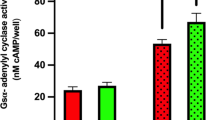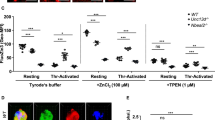Abstract
Abnormalities in the cAMP-dependent protein kinase (PKA), a central component of cAMP signaling, have been reported in several psychiatric disorders. Previous studies showed cAMP signaling alterations in schizophrenic patients but less is known about the involvement of PKA in such disorder. Therefore, we investigated the PKA subunits by Western blot analysis in platelets from 12 patients with schizophrenia and 13 controls. The results showed that the immunolabeling of the PKA regulatory subunits type I (RI) and type II (RII) was significantly reduced in patients compared with controls whereas no differences were observed in the catalytic (C) subunit of the enzyme. These preliminary data suggest that schizoprenic patients have altered PKA levels, thus supporting that dysfunctions in the components of cAMP signaling may contribute to the pathophysiology of schizophrenia.
Similar content being viewed by others
Main
Schizophrenia is a severe and common disorder that typically strikes young people. Although several neurotransmitters seems to be involved in schizophrenia (Kapur and Remington 1996; Tamminga 1998), the molecular mechanisms underlying its pathophysiology are essentially unknown.
The cAMP signal cascade is implicated in the intracellular events mediated by various neurotransmitters and previous studies have shown abnormalities in components of cAMP signaling in schizophrenia. It has been reported lower levels of Giα (Okada et al. 1991; Nishino et al. 1993; Yang et al. 1998) whereas the cAMP response to forskolin as well as the binding of forskolin to adenylyl cyclase were found significantly elevated in schizophrenic patients (Kerwin and Beats 1990; Natsukari et al. 1997). These alterations may have associated effects on PKA, a crucial component of cAMP signaling which mediates most of the actions of cAMP, including the regulation of gene expression (Spaulding 1993). In this regard, an increase in the cAMP binding to PKA was reported in schizophrenic patients (Nishino et al. 1993).
It has been established that changes in the levels of R subunits, which represent the cAMP receptors, and of C subunits of PKA are one of the mechanisms by which the enzyme accomplishes its regulation (Spaulding 1993). Within the context of psychiatric disorders we have recently reported abnormal levels of PKA subunits in platelets from patients with bipolar disorder (BD) or obsessive compulsive disorder (OCD) (Perez et al. 1999; Perez et al. 2000). However, no evidence is available about the levels of PKA in schizophrenia. Therefore, we designed this study in which the levels of PKA subunits were assessed in platelets from schizophrenic patients.
Methods
This study was performed in accordance with the ethical standards laid down in the Declaration of Helsinki.
The patients’ group included 12 subjects (4 male/8 female; age, 41.6 ± 7.5 years) recruited at the Psychiatric Rehabilitation Center, Fatebenefratelli, Brescia, Italy. All patients met the DSM-IV criteria for schizophrenia and were assessed by means of the BPRS. The age at onset and the duration of illness were 23.5 ± 3.5 and 18.1 ± 8.0 years, respectively. All patients received typical antipsychotics as maintenance therapy and underwent a washout period of at least two weeks before entering into the study.
Patients with other axis I diagnosis, organic illnesses, history of alcohol or drug abuse were excluded. The comparison group included 13 volunteers (6 male/7 female; age, 39.1 ± 8.3 years) physically healthy without any history of mental or medical disorders and free of drug treatments for at least two weeks.
Before enrollment in the study each subject or his/her legal caregiver signed an informed consent, after the aims of the study had been explained.
A morning blood sample was obtained from all subjects. Platelets were isolated and processed by personnel blinded to diagnosis as described elsewhere (Perez et al. 1999).
Aliquots of platelet proteins (5 μg) were subjected in duplicate to SDS-PAGE and then transferred to PVDF membranes. Patients' samples were always run on the same gel with those of control subjects. Immunoblotting experiments were performed as previously described (Perez et al. 1999). Briefly, the membranes were incubated in TBST buffer pH 7.6 containing 1% of BSA in the presence of monoclonal antibodies against the RI, RII and C subunits of PKA (dilution: 1/500) and actin (dilution: 1/3500). Quantification of the immunoblots and normalization of the data were performed as previously described (Perez et al. 1999).
Comparisons between groups were performed using two-tailed Student's t tests. Data are expressed as means ± SD.
Results
The levels of PKA subunits and actin, a cytoskeletal protein used as internal control, were assessed in platelets from schizophrenic patients and controls. As shown (Figure 1 ), the immunolabeling of both RI and RII was significantly lower in patients than in comparison subjects (p = .014 and p = .006 respectively) whereas no differences were observed in the immunolabeling of the C subunit and actin between patients and controls.
PKA subunits and actin immunoreactivity in platelets from schizophrenic patients and control subjects. Left panel: Data are expressed as standardized densitometry units (mean ± SD). Right panel: representative immunoblots of PKA subunits and actin from patients with schizophrenia and control subjects.
Discussion
Our study demonstrates that schizophrenic patients have significantly lower levels of platelet PKA R subunits than controls without changes in the immunolabeling of the C subunit. Interestingly, unlike in schizophrenia the R subunits were found significantly increased in OCD and unchanged in BD while lower and higher levels of C subunits were observed in OCD and BD, respectively (Perez et al. 1999; Perez et al. 2000). Indeed, the way in which the enzyme is altered in schizophrenia seems to be specific.
Great care is necessary in interpreting data coming from peripheral cells which are exposed to a different neurohormonal environment than that of brain tissue. Given the reported involvement of PKA in the action of antipsychotics (Adams et al. 1997), the possible role of pharmacological treatments in producing the observed alterations cannot be fully excluded even though patients were drug free for at least two weeks. The reduced levels of R subunits are unlikely to be the result of a general alteration of platelet proteins because the immunolabeling of actin showed no change between groups.
Whether the observed alterations are a primary condition or the consequence of adaptive response to other cell dysfunctions is still unclear. It has been established that exposure to cAMP could modulate PKA levels either through altered stability of its subunits or by changes in transcriptional or posttranscriptional processes (Spaulding 1993). Viewed in this light, the decreased R subunits may be attributed to the reduction of the Giα and the increased cAMP formation reported in schizophrenic patients (Kerwin and Beats 1990; Nishino et al. 1993; Natsukari et al. 1997; Yang et al. 1998). Considering the crosstalk among signaling pathways, the reduced R subunits may be related to the increased activity of the phosphoinositide transduction system (Natsukari et al 1997; Jope et al. 1998; Yang et al. 1998).
We are aware that more studies are needed to delineate the relevance of our findings. However, the reduction in the R subunits, albeit relatively modest, may explain alone or in combination with other dysfunctions, certain clinical and pharmacological features of schizophrenia. This hypothesis is supported by studies showing that PKA could play a key role in the regulation of motor and emotive behavior, memory, stress and also in the action of psychotropic medications (Abel et al. 1997; Duman et al. 1997; Adams et al. 1997; Brandon et al. 1998).
Although further replication in a larger group of subjects is needed, these preliminary data suggest an involvement of PKA in schizophrenia. Accordingly, this study adds to the growing evidence suggesting that PKA might contribute, albeit in a somewhat different way, to the pathophysiology of psychiatric disorders, thus delineating an emerging biochemical explanation to the possible relationship among affective disorders, OCD and schizophrenia.
References
Abel T, Nguyen PV, Barad M, Deuel TAS, Kandel ER, Bourtchouladze R . (1997): Genetic demostration of a role for PKA in the late phase of LTP and in hippocampus-based long-term memory. Cell 88: 615–626
Adams MR, Brandon EP, Chartoff EH, Idzerda RL, Dorsa DM, McKnight GS . (1997): Loss of haloperidol induced gene expression and catalepsy in protein kinase A-deficient mice. Proc Natl Acad Sci USA 94: 12157–12161
Brandon EP, Logue SF, Adams MR, Qi M, Sullivan SP, Matsumoto AM, Dorsa DM, Wehner JM, McKight GS, Idzerda RL . (1998): Defective motor behavior and neural gene expression in RIIβ-protein kinase A mutant mice. J Neurosci 18: 3639–3649
Duman RS, Heninger GR, Nestler EJ . (1997): A molecular and cellular theory of depression. Arch Gen Psychiatry 54: 597–606
Jope RS, Song L, Grimes CA, Pacheco MA, Dilley GE, Li X, Meltzer HY, Overholser JC, Stockmeier CA . (1998): Selective increases in phosphoinositide signaling activity and G protein levels in postmortem brain from subjects with schizophrenia or alcohol dependence. J Neurochem 70: 763–771
Kapur S, Remington G . (1996): Serotonin-dopamine interaction and its relevance to schizophrenia. Am J Psychiatry 153: 466–476
Kerwin RW, Beats BC . (1990): Increased forskolin binding in the left parahippocampal gyrus and CA1 region in post mortem schizophrenic brain determined by quantitative autoradiography. Neurosci Lett 118: 164–168
Natsukari N, Kulaga H, Baker I, Wyatt RJ, Masserano JM . (1997): Increased cyclic AMP response to forskolin in Epstein-Barr virus transformed human B-lymphocytes derived from schizophrenics. Psychopharmacol 130: 235–241
Nishino N, Kitamura N, Hashimoto T, Kajimoto Y, Shirai Y, Murakami N, Nakai T, Komure O, Shirakawa O, Mita T, Nakai H . (1993): Increase in [3H]cAMP binding sites and decrease in Giα and Goα immunoreactivities in left temporal cortices from patients with schizophrenia. Brain Res 615: 41–49
Okada F, Crow TJ, Roberts GW . (1991): G protein (Gi, Go) in the medial temporal lobe in schizophrenia. Preliminary report of a neurochemical correlate of structural change. J Neural Transm (GenSect) 84: 147–153
Perez J, Tardito D, Mori S, Racagni G, Smeraldi E, Zanardi R . (1999): Abnormalities of cyclic adenosine monophosphate signaling in platelets from untreated patients with bipolar disorder. Arch Gen Psychiatry 56: 248–256
Perez J, Tardito D, Ravizza L, Racagni G, Mori S, Maina G . (2000): Altered cAMP-dependent protein kinase in platelets of patients with obsessive compulsive disorder. Am J Psychiatry 157: 284–286
Spaulding SW . (1993): The ways in which hormones change cyclic adenosine 3′,5′ -monophosphate-dependent protein kinase subunits, and how such changes affect cell behavior. Endocrin Rev 14: 632–650
Tamminga CA . (1998): Schizophrenia and glutamatergic transmission. Crit Rev Neurobiol 12: 21–36
Yang CQ, Kitamura N, Nishino N, Shirakawa O, Nakai H . (1998): Isotype-specific G protein abnormalities in the left superior temporal cortex and limbic structures of patients with chronic schizophrenia. Biol Psychiatry 43: 12–19
Acknowledgements
This work was supported in part by the Instituto Scientifico HSR (grant 2511).
Author information
Authors and Affiliations
Corresponding author
Rights and permissions
About this article
Cite this article
Tardito, D., Tura, G., Bocchio, L. et al. Abnormal Levels of cAMP-dependent Protein Kinase Regulatory Subunits in Platelets from Schizophrenic Patients. Neuropsychopharmacol 23, 216–219 (2000). https://doi.org/10.1016/S0893-133X(99)00161-X
Received:
Revised:
Accepted:
Issue Date:
DOI: https://doi.org/10.1016/S0893-133X(99)00161-X
Keywords
This article is cited by
-
Myospryn deficiency leads to impaired cardiac structure and function and schizophrenia-associated symptoms
Cell and Tissue Research (2021)
-
Proteome Analysis of PC12 Cells Reveals Alterations in Translation Regulation and Actin Signaling Induced by Clozapine
Neurochemical Research (2021)
-
Chronic administration of aripiprazole activates GSK3β-dependent signalling pathways and up-regulates GABAA receptor expression and CREB1 activity in rats
Scientific Reports (2016)
-
Aripiprazole Increases the PKA Signalling and Expression of the GABAA Receptor and CREB1 in the Nucleus Accumbens of Rats
Journal of Molecular Neuroscience (2016)
-
Drug-Induced Decrease of Protein Kinase A Activity Reveals Alteration in BDNF Expression of Bipolar Affective Disorder
Neuropsychopharmacology (2004)




